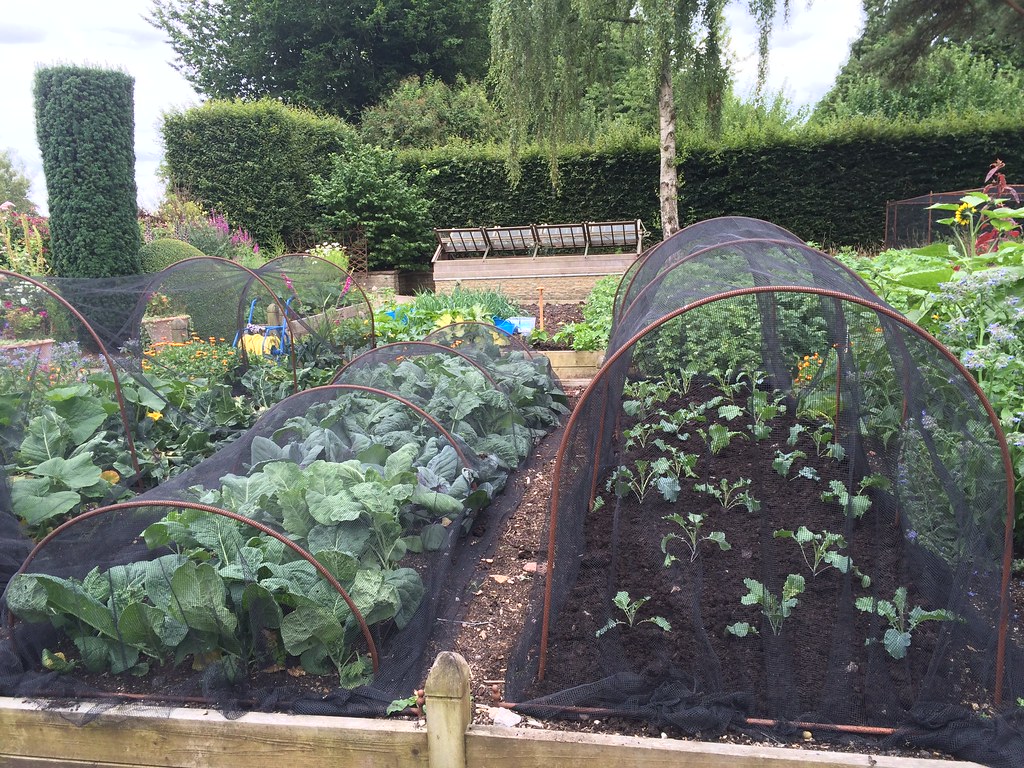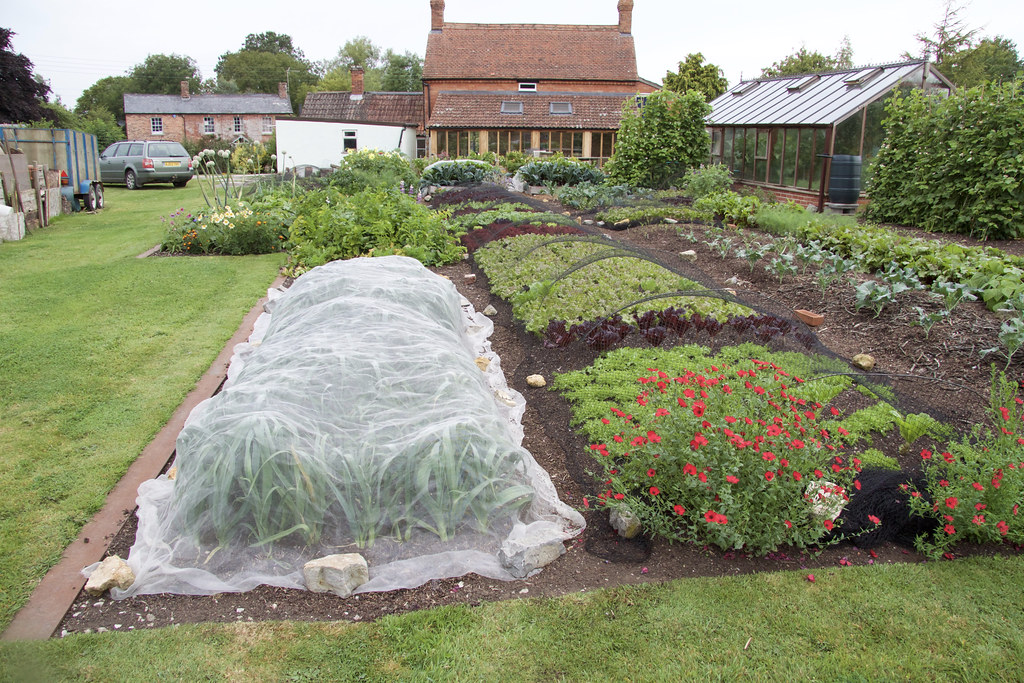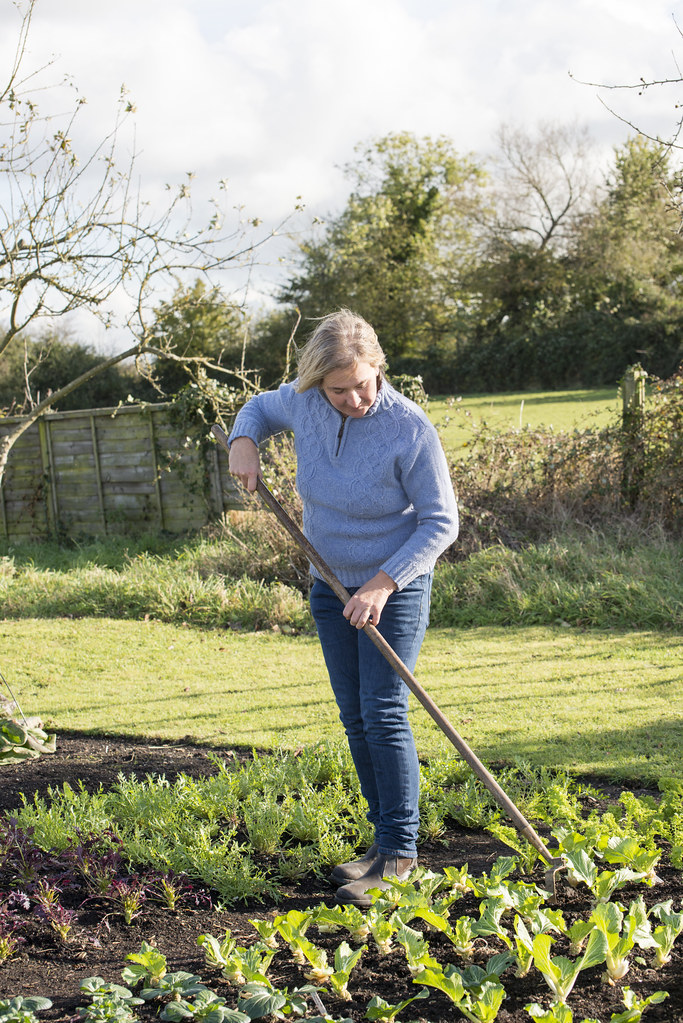Steph Hafferty will be joining us at the National Permaculture Convergence in Oxford this September, along with over 50 other workshop presenters. Here, Steph shares her top 10 tips for starting a No Dig Garden.
 1. How do I begin no dig in my garden?
1. How do I begin no dig in my garden?
It depends what you are starting with! When I changed my allotment to no dig, it was already mostly weed free and I had been growing there for a few years. So I removed any weeds and veg plants that were finished, spread the compost and stopped digging.
If you are starting with a very weedy plot or area which has not been used for growing before (a lawn, weedy pasture etc), first of all cut, mow or strim the weeds to ground level; rake them up and compost. It is best not to leave the cut weeds in situ as they can provide a cosy habitat for slugs and other pests.
Remove woody weeds, brambles, docks, etc, by hand with a spade or trowel. Then cover with either…
- 6 inches/15 cm of well rotted compost or
- a good layer of cardboard and then at least 2 inches/ 5cm of well rotted compost. Both methods exclude light, which helps kill off the weeds.
Worms love cardboard and happily incorporate it into the soil. We use brown card with minimal printing. Cardboard can be either underneath the compost or on top, whichever works best for you. Card on the top will need weighing down with something to prevent it from blowing away. Another alternative is mulching with polythene or membrane. Always put this on the top, not underneath the compost!
After cutting down and removing weeds, spread two inches/ 5cm (or more if you have it) of compost and cover with the polythene. You can make holes in this and grow squash, courgettes or similar large plants, making that area productive whilst the plastic kills off the weeds (source previously used plastic, to save resources). The composted mulch provides habitat for a wide range of creatures, including spiders and black beetles.
2. What is meant by well rotted compost?
In a mild, temperate sluggy country like the UK, well rotted composts are the best mulches for growing no dig. This is based on decades of gardening experience, trials and experiments.
Compost can be well rotted homemade compost, animal manure, leaf mould, municipal waste compost, composted woodchip or spent mushroom compost. Well rotted compost is usually dark, crumbly and smells sweet and earthy. It looks beautiful.
If you have a choice of composts available, use the least rotted first as a base layer, with the finest compost as your surface layer, to sow and plant into. If you want to make more of your own compost, befriend neighbours and collect their grass clippings, vegetarian pet bedding (rabbits, guinea pigs, gerbils, etc), chicken house poo, brown card packaging and kitchen waste. Forage for nettles and comfrey to add to your heap.
Some no dig techniques advise mulching with fresh wood chips, straw, hay, leaves or other uncomposted materials. These work very well in other countries, but in the UK they can cause problems, providing habitat for slugs, snails, woodlice and rodents.

3. What about perennial weeds such as couch, bindweed or creeping buttercup?
Light excluding mulches kill off these weeds, it just takes time (usually a year) and a trowel. Creeping buttercup, bindweed, couch, creeping thistle, dandelions, nettles, clover and annual weeds have all been cleared without digging.
During the first year we regularly checked for any stray weeds that popped up through the mulch and removed them with a trowel. The six inches of compost on top of the weedy pasture meant the garden could be planted as the weeds below were dying off, making it almost instantly productive.
4. Do I need to dig first or loosen the soil?
No, it is better to preserve the existing structure and soil life. The surface mulch of organic matter (compost) soon encourages soil organisms (worms and other soil flora and fauna) whose activity creates a good structure for growth. This is especially true on clay soils, as it quickly becomes sticky and tricky to work with.
I grow on heavy clay; Charles’ (Dowding) previous garden included areas of heavy clay which had been compacted by tractors for decades. Sometimes people say that you need to dig to improve drainage. Of course there will be some extreme situations where digging drainage channels might be necessary, but usually the benefits of no dig help to improve drainage issues too, as the soil life works to improve soil conditions.
5. What do I do if my soil is compacted?
Often what is said to be compacted is really just very firm, but even compacted soils (see above) can be brought into productivity using surface mulches, which are incorporated by the soil life. There is usually no need to break up the soil in order to grow.
6. How do I make the paths?
If you are starting on weedy ground, a mulch of two layers of good strong cardboard, weighed down with stones or timber, kills off the weeds underneath, usually over 9-12 months. You may need to replace the cardboard once or twice (just add more to the surface), depending on your weather conditions.
When all of the weeds are dead, spread some compost or wood shavings onto the paths, to create a surface that is weed free and easy to hoe. Some people like to use wood chips on paths. We find that woodlice move in (and then eat the living plants) and birds fling the chips about onto the beds, as they search for insects so prefer not to use it here.
Grass paths can be difficult to maintain, requiring edging and regular mowing, so we don’t recommend them.
 7. Do carrots and parsnips go down into undug soil?
7. Do carrots and parsnips go down into undug soil?
Parsnips, carrots and other root vegetables grow beautifully in no dig beds, including heavy clay soils, with no need for soil cultivation – their roots descend and swell. Sow into the surface layer as usual, even well rotted animal manure. This does not cause forking because it is not dug in (forking can occur when manure is dug into the soil, not an issue with no dig!)
To harvest carrots, just pull out, or wiggle a trowel next to them to loosen before pulling. We use a spade or fork to harvest parsnips, wiggling close to the parsnip before pulling. It is a loosening procedure, rather than digging over. Level off again with a rake after harvesting.
8. How do I grow potatoes no dig?
There are different ways to grow potatoes no dig. You can …
- lay the potatoes on the surface and cover with several inches of compost, adding to this as the potato leaves grow, to earth up. To harvest, pull the plant – most of the potatoes will come straight out, use your hands or a trowel to find any stragglers.
- use a trowel to make a hole in the ground, place the potato in and earth up with the surrounding compost on the bed as necessary. Harvest using a trowel (it’s rather like an archeological excavation, children love it!)
9. How do I keep the plot weed free?
No dig = fewer weeds! Turning the soil over exposes annual weed seeds which encourages germination (think of the flush of weed seedlings that usually appear a few weeks after a plot is dug over); in no dig, we are not doing this and so those weeds remain dormant.
Of course no dig doesn’t form a magical barrier against weeds – they still blow onto the plot or are dropped there by birds. To help keepyour plot weed free, hoe regularly and trowel out any perennial or larger weeds that escape hoeing. I hoe my allotment every 2 weeks during the main warmer growing seasons, it takes less than 15 minutes to hoe the whole plot.
Maintaining your edges is key too, especially if your plot is adjacent to grassy areas or weedy allotment neighbours. Using a sharp spade or edging tool, maintain your edge and remove any invading weeds with a trowel. We compost all of these, adding to the fertility of our plots.
10. Can I use green manures in no dig beds?
An annual mulch of an inch or two (2.5 – 5 cm) of well rotted compost provides food for the soil and plants for a whole year, even hungry feeders. Most of our beds have two or three harvests a year (some four, if you include catch crops such as radish), all fed using this one annual mulch.
Homemade plant feeds using comfrey, nettles and other nutrient rich plants are very useful for pots. It is fine to use them on your beds too, if you want to.
Some green manures can work in a no dig system, especially those that are killed by the frost, but we rarely have the space to sow them at the right time (often September) as the beds are still full of veg. They can be a useful way of making more material for the compost heap – grown, chopped and composted. In hot, dry countries green manures can be used in a chop and drop method, but in the UK this can create habitat for slugs, so we cut and compost!
Find out more on Steph's blog. You can also see her in conversation with Richard Perkins last month.